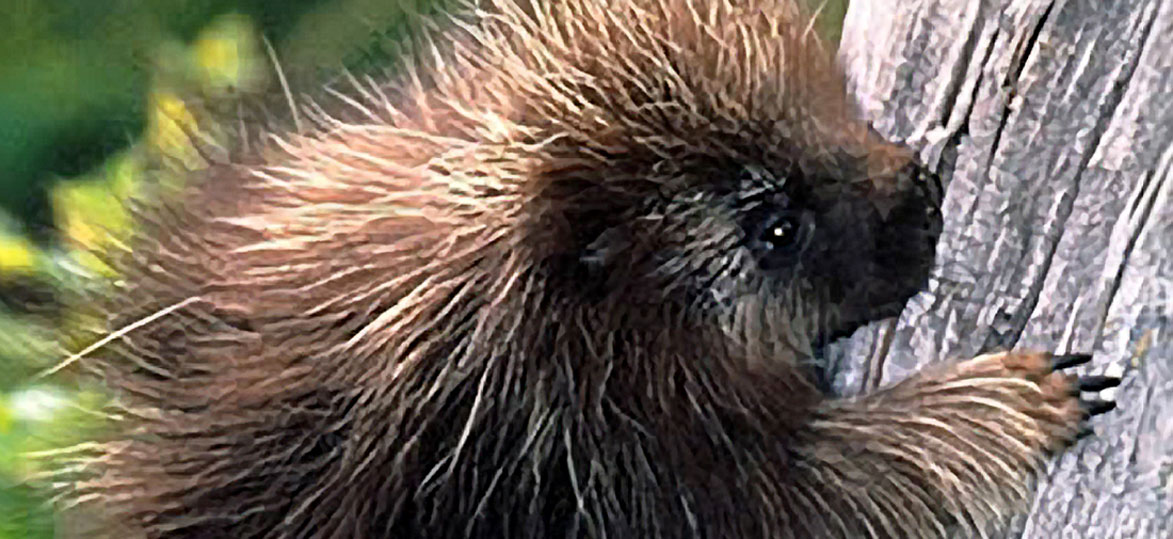
The porcupine (Erethizon dorsatum) is best known for the sharp quills that cover its body. A slow moving, medium-sized mammal, the porcupine has poor eyesight and relies on its sense of hearing and smell, as well as its quills to avoid predators.
The quills are a formidable defense, and only the fisher is consistently quick and agile enough to avoid them. The quills are barbed, which hinders removal, and they slowly work their way from the outside of the animal to the inside, and then back out again. An animal hit in a vital area can die. As a result most wild animals avoid the porcupine.
Habitat
The porcupine is generally found in coniferous forests, but may also frequent mixed or deciduous stands in search of food. Each adult porcupine has a home range of six to 14 acres in size, depending on food availability. The porcupine tends to stay in the same home range and reuses the same den year after year.
It is solitary by nature but may den with other porcupines in the winter. The porcupine does not hibernate, but will stay in dens during bad weather. It may build a nest but also might den in a hollow log or tree, rock ledge, abandoned burrow of another animal, under a stump or blown down tree, or even under a building.
It is primarily nocturnal, mostly active at night, but does forage during the day. When not seeking cover from the weather or fishers, the porcupine spends most of its time in the trees feeding and resting.
When confronted, the porcupine will place his nose between his front legs and spin around so that its tail end is facing the predator. If it is attacked, the porcupine will strike its assailant with its tail and the easily detachable quills will become embedded in the skin of the attacker.
A common misconception is that the porcupine has the ability to eject or throw its quills, but this is not true. The quills are designed to release when coming into contact with another animal.
Reproduction
The porcupine is a solitary for most of the year. However, between September and December, it seeks out other porcupines for mating.
The courtship ritual includes a variety of strange vocalizations from both the male and female as well as a great deal of nose rubbing. Rival males may fight one another to determine who will mate with a female.
After a gestation period of seven months, one baby is born between April and June. Twins are uncommon. The young porcupine, or porcupette, weighs approximately one pound and is born precocial, eyes open. Its teeth are well-formed, and its sense of smell and hearing will soon develop.
The porcupette sports a full set of quills that are soft at birth, yet harden within an hour. At two weeks, it feeds on green plants with only occasional nursing, and is fully weaned at three months of age. The porcupette is independent by the age of six months and reaches sexual maturity around a year and a half.
Diet
Porcupines are herbivores, feeding on vegetation and the bark of trees. It can do considerable damage to a commercial forest stand if its population becomes too high.
Their diets vary from winter to summer based on food availability.
Porcupines forage on shrubs, crops, wild flowers, clover, leaves, acorns, tender twigs, roots, seeds, buds, and leaves in spring and summer. In winter, they eat needles and the bark of trees, such as hemlocks, birch, beech, aspen, elm, oak, willow, spruce, fir, and pine.
They have a natural desire for salt, and will search for salt at natural salt deposits and along roadsides. They will also gnaw on the dropped antlers of deer for minerals. They have also developed a taste for plywood, apparently fond of the taste of glue. Other man made items they often chew on include canoe paddles, axe handles or any item that has been soaked in human perspiration over time.
Management
Current porcupine populations within the state of Vermont are stable. There is no active plan designed for this species, but continued monitoring is conducted to ensure that their population remains healthy and abundant in Vermont.
Status
Porcupines are common in Vermont. Their population size can vary depending on food availability and habitat.
